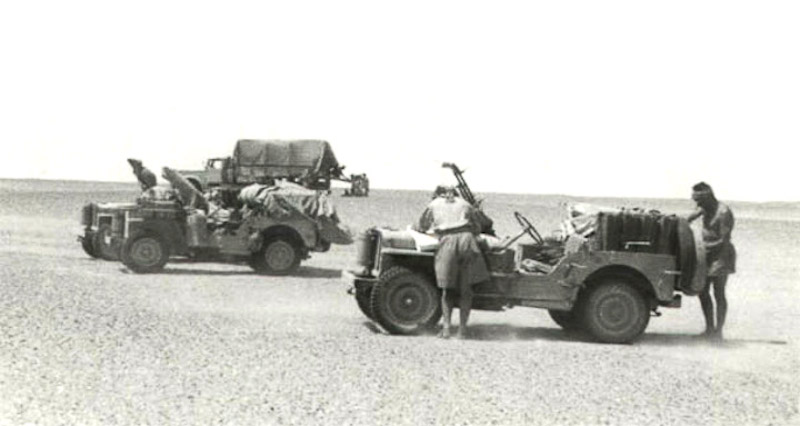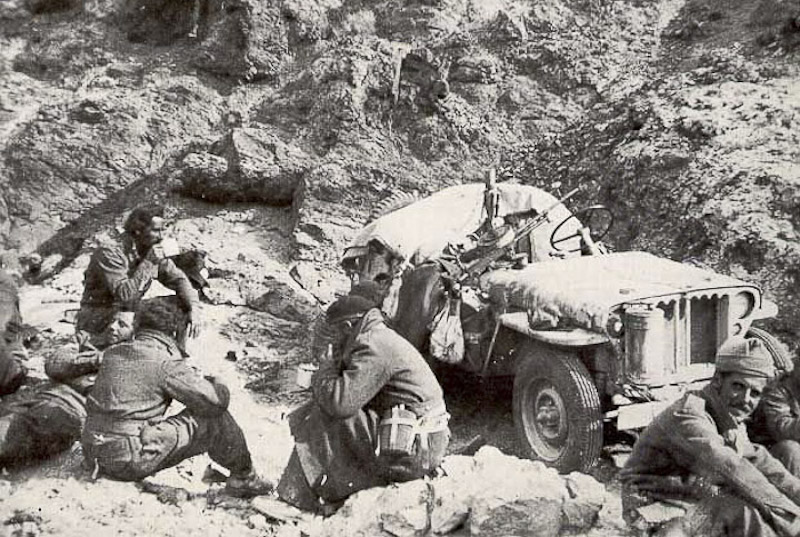It is not uncommon for today’s Overlanders to seek inspiration from previous generations when looking for ideas upon which to base a trip: ‘Following in the footsteps of….’ etc. Few groups can be more heroic than The Long Range Desert Group (LRDG) who operated in North Africa during World War 2.
Based in Cairo, Egypt, this disparate band of highly trained forces wreaked havoc amongst enemy troops in the Sahara by attacking from the direction they least expected – across hundreds of miles of desolate and barren desert. One of their most daring and successful raids was on the Italian Fort and Airfield at Murzuq on 11th January 1941. A force of 76 men in 23 trucks drove a staggering 1200 miles from Cairo to blow up the Airfield and shell the Fort. They used 2 WD Chevy and Ford 30 cwt trucks. These were later supplemented with the Jeep, which proved faster for specialised missions. Such missions often involved the newly formed Special Air Services (SAS) under the orders of David Stirling, founder of the SAS.
Setting off on a mission that may have involved a thousand miles and many days away.
Cooking over an open fire somewhere out in the desert.

Letting the engines cool on a hot day.

Taking a break.
I have been lucky enough over the last 14 years to be working with a group of archaeologists in Libya most winters. I drive out there in my Land Rover and work as photographer and logistics planner. This has given me access to many of the areas of desert the LRDG would have used. I have even found small relics of what could have been one of their camps in Waw en Kebir – a ten mile wide Wadi to the east of Muzuq.


My Egyptian colleague,Mahmoud Marai, has found a few trucks left behing in the retreat from various battles.

Artefacts found in Waw en Kebir.

Also found in Waw en Kebir, a 1941 Shell petrol can.
This January the team was going to be working in Murzuq and would be there on 11th January – the exact anniversary of the raid. When I mentioned the significance of the date, they all showed great enthusiasm. A small group of us decided to find whatever was left 70 years later. First stop would have to be the Fort.
As you enter Murzuq from the Sebha Road, as the LRDG did, the ‘Fort’ is to the west of the town – a Medieval construction in pretty good condition and something of a tourist attraction. A hand painted sign proclaims ‘Fort – Murzuq’ so it would be a fair assumption that this was the fort the LRDG attacked on that victorious day in 1941.

The ‘Fort’ at Murzuq.
But standing in the square it didn’t add up. In all the references I have read, nothing is mentioned of a Mosque, yet it dominates the central square. Also, in Bill Kennedy-Shaw’s book about the LRDG, he says the road led straight to the Fort. This road took several turns! Within our team of archaeologists we were lucky to have Dr. Martin Sterry. Martin’s specialty is the analysis of areal photography in search of archaeological sites and, by chance, he had a 1958 areal photograph of Murzuq. On it can clearly be seen the old sand track into town, leading to another fort. This second fort is a more likely candidate, as it is still a military establishment today.

A 1958 photograph clearly shows a second Fort and the possible remains of the Hanger.
We made that our first destination, but it was crawling with soldiers and despite an hour’s negotiation with the Commander, we had to give up the idea of getting a photograph.
He said he would have to get clearance from The Minister of Defence!

A shame there was so much secrecy, as you can see the fort quite clearly on Google Earth!
I did, however, grab a shot as we drove along the very approach road the LRDG must have driven along as they ‘managed a good shot at the tower’. It is also much nearer to the Airfield – something else mentioned in other reports.

The Fort today. Heavily guarded by soldiers and impossible to get permission to photograph.

A recent Google earth image shows the proximity of the sites.
Martin had also spotted the remains of a rectangular structure about a mile away, measuring 150 feet x 60 feet. Could this be the Aircraft Hanger?

The latest Google Earth image still shows what we hoped would be the Hanger.
We drove out of town to the east and turned off the road, bumping along various tracks through rough farm land until, with great excitement, we could see a large building with no roof.
Having negotiated various natural barriers, we saw before us the unmistakable remains of the Aircraft Hanger almost as it had been left 70 years ago, minus the wrecks of the three planes that were destroyed. (I have read a report that says they were still there in 1968.) A farmer working nearby confirmed we were actually on the old Italian Airfield and the runway, which would have just been flattened sand, was under our feet!
To actually stand on the very spot this raid took place 70 years beforehand was a moving moment. It was easy to imagine the mayhem that would have ensued as the Chevy’s roared up, guns blazing, and the smell of the petrol being thrown over the three Ghibly aircraft to create the fire that destroyed the roof, yet clearly did little more damage.




The hanger as it stands today, complete with bullet holes!

And as it was on the afternoon of January 11th 1943. Just visible are the two windows set high in the west facing wall.
It had been a productive day and inspired us to visit other sites that surely still exist, the remoteness of the desert preserving so many things lost in the cultivated World. To this end we are running an ambitious trip out of Cairo this Easter (2011) to recreate a big LRDG expedition in two authentic World War 2 Jeeps.
With the help of two equally enthusiastic friends, Sam Watson, who wrote his masters dissertation on the LRDG, and John Carroll, who has run old Jeeps all his life, we have cooked up a plan to ship my two 1943 Jeeps to Egypt. With the support of a local logistics team, we’ll drive more than 1200 miles over routes used by the LRDG – right down to the border with Sudan, north along the edge of the Gilf el Kebir, across The Great Sand Sea and back to Alexandria for a well deserved ‘Ice Cold in Alex’ moment.

Sam Watson and John Carroll
Because of the enormous costs involved we need to share the experience with five guests. Most of the places have been snapped up, but there is room for one more person to experience this unique trip. Take a look at the web site LRDG Expedition Web Site, or follow progress on the Blog.

The Jeep are ready to go!

There is an excellent dedicated web site to the LRDG that has the full story of their exploits.
Toby Savage is a photographer, writer, adventurer based in the UK. For more information on his work or the upcoming New Desert Adventure check out the following webites www.tobysavage.co.uk & www.tobysavage.co.uk/lrdg/.


